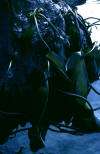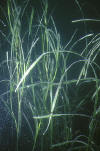Le coste rocciose e sabbiose rappresentano ambienti estremi per la vita vegetale: le piante che vi abitano devono fronteggiare l’azione costante delle onde, la salsedine e i venti secchi provenienti dal mare. Nonostante queste difficoltà, alcune specie vegetali hanno sviluppato adattamenti straordinari per sopravvivere e prosperare in questi habitat. Tra le piante a fiore troviamo la Zostera marina, nota come erba marina, mentre le alghe dominano incontrastate sulle coste rocciose, con una varietà sorprendente di forme, colori e strategie riproduttive.
Le alghe: regine delle scogliere
Le alghe non possiedono vere e proprie radici, ma sono ancorate al substrato tramite strutture chiamate rizoidi o tallofite (holdfast), capaci di aggrapparsi con forza alle rocce. La parte visibile, detta lamina o fronda, si collega al rizoide tramite uno stelo flessibile chiamato stipite. A seconda della posizione lungo la riva, si distinguono tre gruppi principali:
-
Alghe verdi: prevalenti nelle zone superiori.
-
Alghe rosse: dominano nella parte inferiore del litorale.
-
Alghe brune: colonizzano le aree più riparate e profonde.
Vediamo ora alcune tra le specie più caratteristiche.
Laminaria digitata – Oarweed
 Conosciuta anche come “kelp”, cresce sulle rive più basse e nei fondali poco profondi. È facilmente riconoscibile per le fronde a dita, la colorazione bruno-dorata e uno stipite lungo e flessibile. In autunno può produrre fino a 20 miliardi di spore per metro quadro. Molti organismi marini vivono tra le sue ramificazioni, come il mollusco Helcion pellucidium. In passato, i giovani stipiti venivano consumati come alimento in Scozia e Irlanda.
Conosciuta anche come “kelp”, cresce sulle rive più basse e nei fondali poco profondi. È facilmente riconoscibile per le fronde a dita, la colorazione bruno-dorata e uno stipite lungo e flessibile. In autunno può produrre fino a 20 miliardi di spore per metro quadro. Molti organismi marini vivono tra le sue ramificazioni, come il mollusco Helcion pellucidium. In passato, i giovani stipiti venivano consumati come alimento in Scozia e Irlanda.
Laminaria saccharina – Alga zuccherina
 Si distingue per la fronda ondulata e marrone-giallastra, con una polvere biancastra e dolce al gusto. Cresce nelle aree riparate, tra i laminari, e può raggiungere i 4 metri. Veniva un tempo usata come “barometro del povero”, poiché la consistenza della fronda indicava il meteo imminente.
Si distingue per la fronda ondulata e marrone-giallastra, con una polvere biancastra e dolce al gusto. Cresce nelle aree riparate, tra i laminari, e può raggiungere i 4 metri. Veniva un tempo usata come “barometro del povero”, poiché la consistenza della fronda indicava il meteo imminente.
Ascophyllum nodosum – Alga nodosa
È la più grande delle alghe brune del genere Fucus, caratterizzata da sacche d’aria ovali e fronde verdi-oliva. Cresce lentamente e può vivere fino a 12 anni. Piccole alghe rosse, come la Polysiphonia lanosa, crescono spesso sulla sua superficie.
Himanthalia elongata – Thongweed

Comune sulle coste esposte, appena sopra la zona del kelp. È caratterizzata da un piccolo disco centrale da cui partono lunghi nastri riproduttivi. Vive solo 2-3 anni e muore subito dopo la riproduzione.
Fucus serratus – Alga seghettata

Facilmente riconoscibile per il margine dentellato della fronda e la superficie piatta. Fornisce rifugio a numerosi animali marini come periwinkle e piccoli briozoi. Viene raccolta in alcune zone come foraggio o fertilizzante naturale.
Fucus vesiculosus – Alga vescicolosa
 Adattabile sia a coste esposte che riparate, si distingue per le vescicole d’aria presenti in coppia lungo le fronde. Cresce rapidamente e può colonizzare aree spoglie. In passato si usava per curare obesità e malattie delle ossa.
Adattabile sia a coste esposte che riparate, si distingue per le vescicole d’aria presenti in coppia lungo le fronde. Cresce rapidamente e può colonizzare aree spoglie. In passato si usava per curare obesità e malattie delle ossa.
Fucus spiralis – Alga spirale
 Resiste bene alla disidratazione, cresce nella fascia alta del litorale e presenta fronde ritorte. Ogni pianta è ermafrodita e si autoimpollina. In passato, le sue fronde erano impiegate per curare i calli.
Resiste bene alla disidratazione, cresce nella fascia alta del litorale e presenta fronde ritorte. Ogni pianta è ermafrodita e si autoimpollina. In passato, le sue fronde erano impiegate per curare i calli.
Pelvetia canaliculata – Alga canalicolata
 Specializzata per vivere molto in alto sulla riva, quasi solo raggiunta dagli spruzzi. Le fronde concave trattengono l’umidità. Curiosamente, se viene sommersa troppo a lungo, la pianta muore.
Specializzata per vivere molto in alto sulla riva, quasi solo raggiunta dagli spruzzi. Le fronde concave trattengono l’umidità. Curiosamente, se viene sommersa troppo a lungo, la pianta muore.
Cystoseira tamariscifolia – Alga arcobaleno

Rara e visibile solo nel sud-ovest britannico, si riconosce per il colore iridescente blu-verde e i corpi fruttiferi tondeggianti. Vive nelle pozze di marea sulla riva bassa.
Porphyra umbilicalis – Laver purpurea
 Una delle alghe rosse più conosciute, sopravvive fuori dall’acqua a lungo. È alla base della famosa “Laver bread” gallese. È commestibile anche in Giappone, dove viene usata per gli involtini di riso. Ricca di proteine, vitamina B e C.
Una delle alghe rosse più conosciute, sopravvive fuori dall’acqua a lungo. È alla base della famosa “Laver bread” gallese. È commestibile anche in Giappone, dove viene usata per gli involtini di riso. Ricca di proteine, vitamina B e C.
Chondrus crispus – Muschio d’Irlanda
 Alghe rosse resistenti, si trovano anche in acque salmastre. Da esse si estrae il carragenano, una sostanza usata nell’industria alimentare e cosmetica (gelati, shampoo, dentifrici).
Alghe rosse resistenti, si trovano anche in acque salmastre. Da esse si estrae il carragenano, una sostanza usata nell’industria alimentare e cosmetica (gelati, shampoo, dentifrici).
Enteromorpha intestinalis – Alga intestinale
 Verde brillante, cresce in abbondanza in pozze d’acqua alte. Rapida colonizzatrice, è stata tra le prime a ricrescere dopo lo sversamento del petrolio della Torrey Canyon (1967). In Asia è consumata come alimento.
Verde brillante, cresce in abbondanza in pozze d’acqua alte. Rapida colonizzatrice, è stata tra le prime a ricrescere dopo lo sversamento del petrolio della Torrey Canyon (1967). In Asia è consumata come alimento.
Ulva lactuca – Lattuga di mare
 Molto comune, forma fronde verdi e sottili come carta, e si sviluppa anche come massa galleggiante. In Galles viene talvolta usata al posto del laver per la preparazione del “larver bread”.
Molto comune, forma fronde verdi e sottili come carta, e si sviluppa anche come massa galleggiante. In Galles viene talvolta usata al posto del laver per la preparazione del “larver bread”.
La Zostera marina: una pianta a fiore in mare
 Unica pianta a fiore delle nostre coste, l’eel grass cresce in acque poco profonde, tra sabbia e fango. Un tempo abbondante, è stata decimata da una malattia negli anni ’30 e ora sopravvive in alcune zone del sud-ovest britannico. Ospita una grande varietà di piccoli animali e costituisce una risorsa alimentare per le oche Brent. In passato veniva usata come imbottitura e per costruire dighe artificiali.
Unica pianta a fiore delle nostre coste, l’eel grass cresce in acque poco profonde, tra sabbia e fango. Un tempo abbondante, è stata decimata da una malattia negli anni ’30 e ora sopravvive in alcune zone del sud-ovest britannico. Ospita una grande varietà di piccoli animali e costituisce una risorsa alimentare per le oche Brent. In passato veniva usata come imbottitura e per costruire dighe artificiali.






